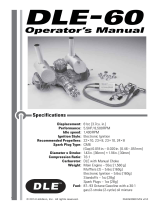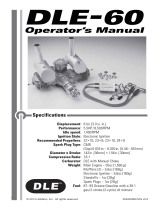Page is loading ...

Model 160G Averaging Air Flow Grid
Specications - Installation and Operating Instructions
Bulletin TE-160G-1
The Model 160G Averaging Air Flow Grid is a precision sensing instrument used
to measure face air velocity on grills, diffusers, registers, exhaust hoods, coils, lters,
dampers and similar restrictions. With its 16 sensing points, the 160G Air Flow Grid
provides an average ow sensing area across its 16.5˝ length and width. Included
color coded tubing connects to the integral barbed ttings, providing a differential
pressure signal to a gage or manometer where the readings can be converted into a
velocity or ow reading. The 160G comes standard with an extendable pole offering
a maximum reach of approximately 48˝. The ball pivot joint and tightening nut allows
the user to position the sensing grid at any angle in any direction for ease of use in
hard to reach locations. Store in the separate UHH-C2 hard carrying case with foam
cut-outs perfectly sized for the 160G, as well as various other instruments in the AQTI
Air Quality Test Instruments line.
Assembly
Attach the Stand-Offs
The 160G comes with two sets of stand-offs (Parts A1 and A2 in Figure 1) that are
different heights and they can be connected to each other to form a third different
height. The stand-offs ensure the air ow grid is sitting perpendicular to the grill to get
the most accurate readings. Once the proper height stand-off is chosen, the bumpers
(Part B in Figure 1) should be attached to the stand-offs to prevent the 160G from
scratching the surface around the grill. The stand-offs can be screwed into the top side
of the air ow grid.
SPECIFICATIONS
Service: Air or compatible gases.
Wetted Materials: Grid: Black polycarbonate; Ball pivot joint: AL, plastic; Handle:
Aluminum; Standoffs: Aluminum with rubber bumpers, two sets: 1.25˝ (31.7 mm)
and 2˝ (50.8 mm), 1/8˝ ID / 1/4˝ OD; Tubing: Two 10´ (3 m) lengths of silicone
rubber.
Accuracy: ±2% FS.
Temperature Limits: -40 to 257°F (-40° to 125°C).
K Factor: 0.84.
Range: 1000 to 5000 FPM (5 to 25 m/s).
Process Connection: 1/8 to 1/4˝ ID tubing.
Weight: 1.75 lb (0.79 kg).
Agency Approvals: RoHS.
16-15/32
[418.34]
16-15/32 [418.34]
5-27/32
[148.34]
TYP.
4-7/8
[123.95]
TYP.
4
[101.60]
3-3/16
[80.78]
22-1/2 [571.59]
36-1/8 [917.58]
POLE RETRACTED
POLE EXTENDED
Attach the Handle
One extendable pole is included to reach a maximum of 48˝. The pole (Part E in Figure
1) will slide into the bottom feature on the adapter (Part D2 in Figure 1) and afx to the
adapter with the push button pin (Part D3 in Figure 1). The adapter will then thread into
the female thread on the ball pivot joint (Part D1 in Figure 1). Next, the male thread
on the ball pivot joint will thread into the air ow grid on the opposite side of the stand-
offs. The plastic nut on the ball pivot will lock the air ow grid in place and prevent it
from spinning once it is tightened. Finally, the user can adjust the ball pivot to adjust
the angle at which the air ow grid is going to measure. In order to adjust the angle of
the air ow grid, the user will loosen the plastic wing nut located on the side of the ball
pivot and tighten at desired angle.
Connect Tubing
The tubing provided with the air ow grid is color coordinated to help identify which
tube is going to the high pressure port and which tube is going to the low pressure
ports on both the manometer and the air ow grid. For return air grill, the pressure port
on the side of the swivel is the total/dynamic pressure (high pressure) and the pressure
port on side of the stand-offs is the static (low pressure). For a supply air grill, the ports
would be reversed.
MAINTENANCE/REPAIR
Upon nal installation of the Model 160G, no routine maintenance is required. The
Model 160G is not eld serviceable and should be returned if repair is needed. Field
repair should not be attempted and may void warranty.
WARRANTY/RETURN
Refer to “Terms and Conditions of Sales” in our catalog and on our website. Contact
customer service to receive a Return Goods Authorization number before shipping the
product back for repair. Be sure to include a brief description of the problem plus any
additional application notes.
Printed in U.S.A. 7/18 FR# 444048-10©Copyright 2018 Dwyer Instruments, Inc.
Figure 1
E
D3
D2
D1
B
A1 or A2
®
DWYER INSTRUMENTS, INC.
P.O. BOX 373 • MICHIGAN CITY, INDIANA 46360, U.S.A.
Phone: 219/879-8000
Fax: 219/872-9057
www.dwyer-inst.com
e-mail: [email protected]
/



